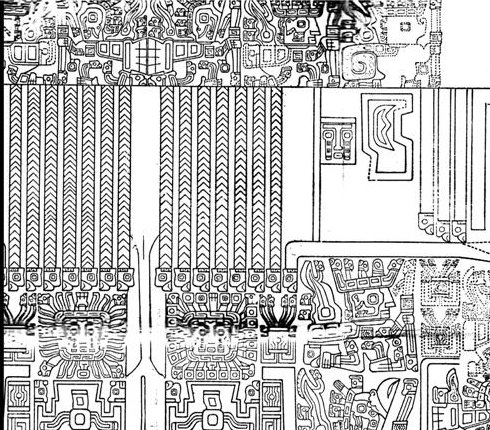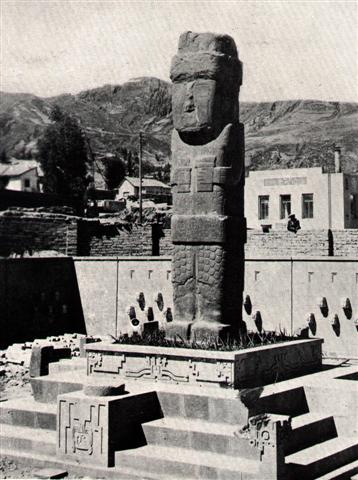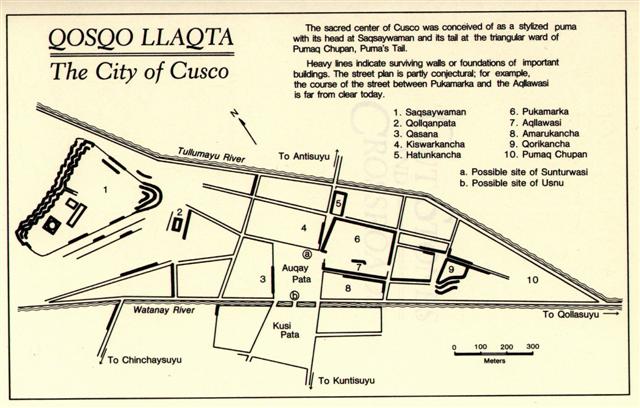At the back side of Pachamama (Mother Earth) we can count the knots in her tresses to be approximately 400 (= 20 * 20):  ... Religion then, as among other peoples of the continent, was an animism based on cosmic philosophy, in which all the phenomena of nature and all visible things which had a relation with material life, were animated. The ground, the food-giving earth, was Pachamama; the moon, Paximama; the lake, Kochomama. Even the wind was a divine being, Huayra-huirakjocha. The hills and especially the volcanos were also considered to be divinities and were called Achachilas. [A footnote explains achachi as grandfather] ... In a first attempt at counting the number of these knots I reached 400:
Later a tried anew: ... Counting again in the undulating tresses of Pachamama - after having realized it was probably the number of apexes which mattered - the intended order indeed comes clearly into view ...
The right side of her tresses measured half a year, but her left side tresses carried more knots. The Mayan method of counting to 18 uinals (360 days) does not fit. Instead the creator of this marvellous stone statue evidently used a more exact counting amounting to 182 days respectively to 214 (= 182 + 32) nights.
For counting the diurnal days down on earth 360 was appropriate, but for counting the star nights above 396 (= 36 * 11) was better. The gods counted their days in a way which was different from ours. And it would not be strange to count the days of summer, when the Sun king was present, separately from the nights of winter when he was at the other side of the equator. In Manuscript E we can read how Hotu Matua left his old homeland in Hora Nui 2, which I have suggested was in ºSeptember 2 because Nonoma (probably an alias for Jupiter) was out urinating in the night.
... The canoes of Ava Rei Pua and of Hotu were seen near the (off-shore) islets. On the fifteenth day of the month of October (tangaroa uri) the canoe of Hotu and the canoe of Ava Rei Pua landed. On the fifteenth day of the month of October (tangaroa uri), Nonoma left the house during the night to urinate outside. At this point Ira called out to Nonoma, 'Look at the canoe!' Nonoma ran, he quickly went to Te Hikinga Heru (a ravine in the side of the crater Rano Kau) and looked around. There he saw the double canoe way out near the (offshore) islets, and the two (hulls of the canoe) were lashed together ... In ºSeptember 2 = Hora Nui 2 (at heliacal Zosma and Coxa) - the day after Sirius had risen together with the Sun in *JUNE 30 (181) - Hotu Matua had sailed from his old homeland. In the tresses of Pachamama I reached 78 + 104 = 182 at her right side and Ga4-21 is glyph 104. "... Hotu's canoe sailed from Maori to Te Pito O Te Kainga. It sailed on the second day of September (hora nui) ..." (The Eighth Island) 245 (ºSeptember 2) - 182 (*JULY 1) = 63 precessional days corresponded to a time depth of around 71 * 63 = 4473 years from the time of Gregory XIII. 1582 A.D. - 4473 = -2891. ... The Julian calendar day Thursday, 4 October 1582 was followed by the first day of the Gregorian calendar, Friday, 15 October [sic!] 1582 (the cycle of weekdays was not affected) ... When the Sun king (Hotu Matua) reached Easter Island another calendar should be used, because this land was south of the equator. And as if by chance the Pope had chosen ºOctober 15 as the date of birth for his new calendar. Some quick calculations revealed his new calendar had to be connected with the time of Bharani. Therefore Hotua Matua - alias Noah, Ziusudra, Xisuthros, Ubaradudu, etc - had to be Antares:
From Zosma and Coxa to Antares there were *249 - *169 = 80 days, and this was probably the duration of the King's voyage from Maori to Te Pito O Te Kainga. It was in complete agreement with the Pope's decision to put the spring equinox at day 80 (ºMarch 21).
|
|||||||||||||||||||||||||||||||||||||||||||||||||||||||||||||||||||||||||||||||||||||||||||||||||||||||||||||||||||||||||||||||||||||||||||||||||||||||||||||||||||||||||||||||||||||||||||||||||||||||||||||||||||||||||||||||||||||||||||










